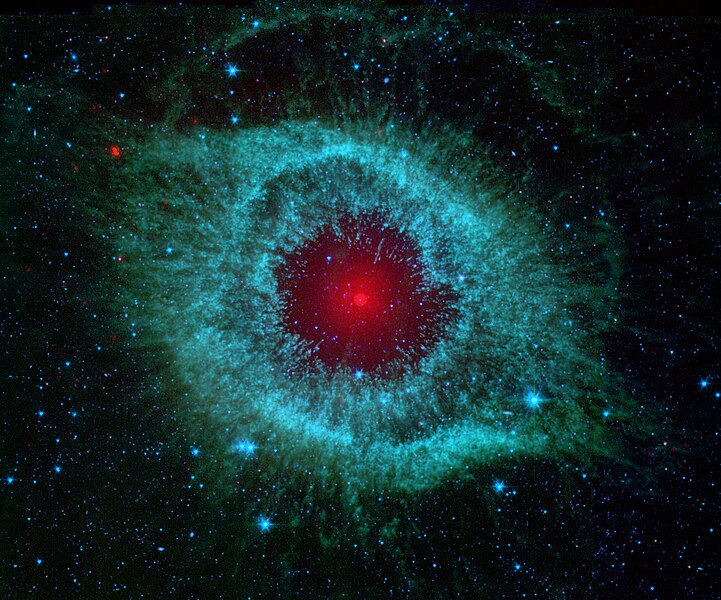English: This infrared image from NASA's Spitzer Space Telescope shows the
Helix Nebula, a cosmic starlet often photographed by amateur astronomers for its vivid colors and eerie resemblance to a giant eye.
The nebula, located about 700 light-years away in the constellation Aquarius, belongs to a class of objects called planetary nebulae. Discovered in the 18th century, these colorful beauties were named for their resemblance to gas-giant planets like Jupiter.
Planetary nebulae are the remains of stars that once looked a lot like our sun. When sun-like stars die, they puff out their outer gaseous layers. These layers are heated by the hot core of the dead star, called a white dwarf, and shine with infrared and visible colors. Our own sun will blossom into a planetary nebula when it dies in about five billion years.
In Spitzer's infrared view of the Helix nebula, the eye looks more like that of a green monster's. Infrared light from the outer gaseous layers is represented in blues and greens. The white dwarf is visible as a tiny white dot in the center of the picture. The red color in the middle of the eye denotes the final layers of gas blown out when the star died.
The brighter red circle in the very center is the glow of a dusty disk circling the white dwarf (the disk itself is too small to be resolved). This dust, discovered by Spitzer's infrared heat-seeking vision, was most likely kicked up by comets that survived the death of their star. Before the star died, its comets and possibly planets would have orbited the star in an orderly fashion. But when the star blew off its outer layers, the icy bodies and outer planets would have been tossed about and into each other, resulting in an ongoing cosmic dust storm. Any inner planets in the system would have burned up or been swallowed as their dying star expanded.
So far, the Helix nebula is one of only a few dead-star systems in which evidence for comet survivors has been found.
This image is made up of data from Spitzer's infrared array camera and multiband imaging photometer. Blue shows infrared light of 3.6 to 4.5 microns; green shows infrared light of 5.8 to 8 microns; and red shows infrared light of 24 microns.
Français : Image infrarouge de la nébuleuse de l'hélice prise par le télescope spatial Spitzer de la NASA.
La nébuleuse de l'hélice est un grand classique de la photographie astronomique amateur à cause de ses belles couleurs et de sa ressemblance à un œil géant. Cet objet situé dans la constellation des poissons est appelé une nébuleuse planétaire. Découvertes au cours du XVIIIe siècle, les nébuleuses planétaires doivent leur nom à leur ressemblance avec des planètes géantes gazeuses comme Jupiter. Cependant, leur formation est toute différente: lorsqu'une étoile de la taille du Soleil arrive au terme de sa vie, elle expulse ses couches extérieures dans l'espace environnant. Ce gaz est chauffé par ce qui reste du cœur de l'étoile, une naine blanche, et brille de couleurs visibles et infrarouges. Notre Soleil formera une telle nébuleuse planétaire dans cinq milliards d'années environ.
Dans l'image prise par Spitzer, l'œil qui nous regarde semble appartenir à un monstre vert. Le vert et le bleu correspond aux couches gazeuses les plus externes. La naine blanche est visible comme un petit point blanc au centre de l'image. Le rouge correspond aux dernières couches gazeuses expulsées par l'étoile.
La petite zone rouge autour de l'étoile correspondrait à de la lumière émise par un disque de poussières (lui même trop petit pour être vu). Cette poussière proviendrait de comètes ayant survécu à la mort violente de leur étoile. La nébuleuse de l'hélice est l'une des seules ou de telles comètes semblent exister. Lorsque cette étoile s'est transformée en géante rouge, les planètes les plus internes ont été absorbées. Lorsqu'elle a éjecté ses couches extérieures, les autres planètes gravitant autour d'elle ont probablement été détruites, et la survie de comètes est en soi difficile à expliquer.
Cette image a été réalisée à partir de données obtenues par la caméra infrarouge de Spitzer et son photomètre multifréquence. Le bleu correspond à des longueurs d'ondes de 3,6 à 4,5 microns, le vert de 5,8 à 8 microns, et le rouge a des longueurs d'ondes de 24 microns.
Українська: Дане
інфрачервоне зображення
Туманності Равлик, отримане космічним телескопом
НАСА Спітцером, завдяки своїм яскравим кольорам нагадує гігантське
око.
Ця туманність розташована на відстані біля 700
світлових років від
Землі у напрямку
сузір'я Водолій й належить до класу
планетарних туманностей. Вона була відкрита у 18 столітті.
فارسی: تصویر
سحابی هلیکس در نور مرئی گرفته شده توسط
تلسکوپ فضایی هابل در سال ۲۰۰۴ میلادی





